YL+E Creating Your Sanctuary
Family Activities
Let the Light In: Stained Glass
Surround Yourself: Family "Photo" Collage
Where We Pray: Mikdash Me'at (Small Sanctuary) and Mizrah (East)
Creating Intention in Prayer: Kavannah Corner
Marking Holy Space: Mezuzah
Achieving Our Goals for the New Year: Vision Board
The Power of Light: Menorah
The Story of Scratches: Meaningful Objects
Making Space Holy: Bezalel Decorates the Mishkan
Let the Light In: Stained Glass
The Talmud teaches that a synagogue must be built with windows in the sanctuary that let in natural light and let people see outside the synagogue. Many synagogues have beautiful stained glass in their Sanctuary—in order to add beauty, but also to tell a story and teach a lesson. You might see stained glass windows that show the 12 Tribes of Israel, different Torah stories, or scenes from Creation.
Prayer in a Sanctuary can be very communal, but also very personal. Prayer can be a window in which we see the world and work to make it a better place. Create your own piece of stained glass that brings the beauty of the synagogue into your sacred space at home. You can choose to enhance your stained glass by including a phrase or quote from a prayer that is representative of how you want to see the world and how we can work together to make it a better place.
Supplies:
- Paper or construction paper
- Glue or glue stick
- Tissue paper
Directions:
- Tear tissue paper into pieces.
- Sketch out your design on a piece of paper or use one of the provided templates and then cut out the shapes you want to fill with colorful tissue paper.
- Turn your paper over so the back is facing you.
- Glue or tape as many pieces of tissue paper as you’d like in the open spaces. You can stack the tissue paper or leave it in one layer.
- Turn your paper over to see your finished product and lay it out to dry.
Examples:
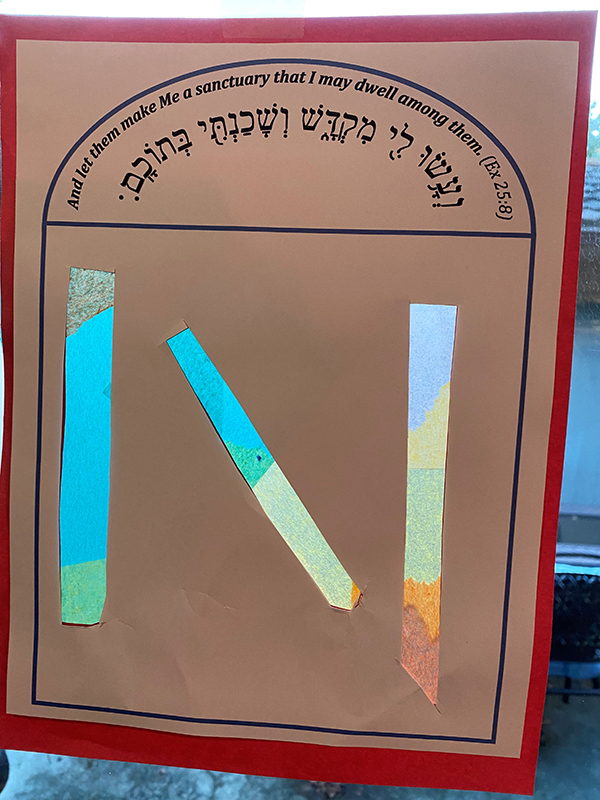
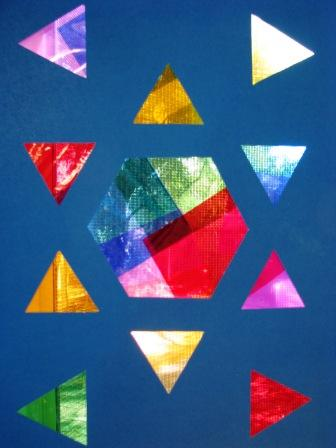
Back to top
Surround Yourself: Family “Photo” Collage
This year, even though we will not be in person to celebrate the holidays and might not have our loved ones around, we can still honor the important familial and communal aspects of the Jewish holidays. Just because we do not have the four walls of the sanctuary and our family surrounding us doesn’t mean that these people can’t help us continue to build our sanctuary.
One thing I love about having my family around is the unique personalities that everyone brings to the table. My grandmother always used to say that the world would be boring if everyone was the same and I think I would have to agree! I also think it would be boring if every member of our family was the same and this is a unique opportunity to recognize the gifts that the people you love being to the holidays.
Supplies:
- Construction Paper
- Markers
- Glue or glue sticks
- Scissors
Directions:
- Gather photos of family members you wish you could be with for the holidays.
- If you have them, cut out photos of the family members, or draw them if you don’t have photos, and glue them onto your paper to create a collage of the people you like to have around your table. That way they can be with you in spirit, even if they can’t be there with you in person.
- Optional: On each person’s picture on the collage write the special gifts that they bring to your sanctuary.
- Finally, take pictures of your collage and send them to everyone featured. Trust me, it will make their day!
Back to top
Where We Pray: Mikdash Me’at (Small Sanctuary) and Mizrah (East)
Part 1: After the Temple was destroyed in 70 CE and the Jews could no longer offer sacrifices to praise God, the Rabbis of the time needed to find a different way for Jews to pray. Among other things, they realized that many important conversations and moments are marked over the dinner table. They deemed it a Mikdash Me’at, a small sanctuary. As you create your Mikdash Me’at this High Holy Day season, include some of these elements.
Directions:
Create tissue paper flowers for your dining room table.
1. This website has four methods you can try, or feel free to create your own: https://heyletsmakestuff.com/our-wedding-paper-flowers-tutorial/
Younger Students:
Create Shanah Tovah (Happy New Year) greeting cards for family members.
1. Use symbols of the season to decorate your cards – apples and honey, round challah, and the shofar.
2. Mail them to family or place the cards at their place at the table if they will be with you.
Older Students:
Create conversation cards for your family to discuss around your Mikdash Me’at during your holiday meals.
1. Use any kind of paper or index card and writing utensil to create and decorate. Then, during the meal, take turns answering the questions on each card. Here are some suggested discussion card questions:
-
-
- What is your favorite Jewish memory? Jewish holiday? Jewish food?
- What is your earliest Jewish memory?
- Who was/is your favorite teacher and what did you love learning from them?
- Who inspires you and why?
- Share the story of a time someone taught you an important Jewish lesson.
- What is a question you have about Judaism and/or being Jewish?
- Feel free to come up with your own as well!

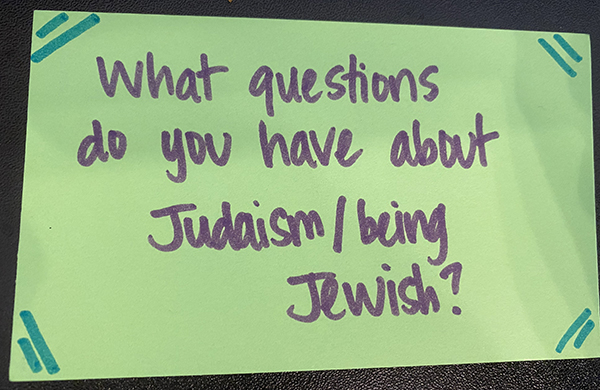
Part 2: When Jews pray, we face East toward Jerusalem. Most Ashkenazic synagogues are constructed so that when you face the ark, you are facing East. In Sephardic synagogues, they pray in the round with the bimah in the middle. Their synagogues have a piece of art on the wall, called a Mizrah, Hebrew for “East,” to show everyone which way Jerusalem is.
If it’s a nice day, go outside (with an adult) and see where the sun is. Since the sun rises in the East and sets in the West, you will be able to tell which is the way to Jerusalem. A Mizrah can have a depiction of Jerusalem, script of the Hebrew word (Mizrah), or other beautiful images.
Directions:
- Choose your paper and markers or other decorating materials. You can use markers, crayons, watercolors or whatever inspires you.
- Create an “East” sign featuring the Hebrew word, mizrach, or מזרח.
- Decorate your sign with images of prayer, the holiday, or Jerusalem.
- Affix the sign on an eastern wall in your home sanctuary so that you know which way to face during prayer.
- Feel free to use these as examples or create your own art as you face Jerusalem.



Back to top
Creating Intention in Prayer: Kavannah Corner
Part of what makes a sanctuary sacred are the objects we fill it with. These objects include both the physical fixtures that remain in the space - the ark, Ner Tamid (eternal light), Ten Commandments – and the objects we bring with us to help prepare us for prayer. Ritual objects including things like kippot or tallit have important religious significance, but for many of us, the meaning and choice of wearing them is very personal. Wearing kippot or tallit can help us feel safe, grounded, and ready to pray. The ritual of bringing them with us and putting them on can bring us great comfort. These objects are full of stories, memories and constant reminders that we are not praying alone.
One of the things we can do to create a sanctuary in our home is to gather objects that bring us comfort or joy and bring them with us into our holy space. In this way, we can work intentionally to bring meaning to our holy spaces at home. Create a Kavanah (intention) corner or box and fill it with stories, love, and sacred things that can help turn any room into a personal sanctuary: a space where you can feel surrounded by comfort, love, and the traditions and people that came before you.
Directions:
1. Collect objects from around your house that tell a story using these prompts, or simply grab things that are meaningful to you.
- An object that reminds you of someone special
- An object that brings you a sense of joy
- An object that makes you feel comfortable
- An object used for special occasions
- An object that gives you a sense of purpose or makes you feel important
- An object that shows who you are
- An object that helps you celebrate Jewish holidays
- An object that is made to last a very long time
- An object made with love
2. Find a box or container that will hold all of your objects if you can. This can be something as simple as a cardboard box, or a plastic bin, or even another object that has meaning to you. If you do not have a box of the appropriate size, choose a corner of the room to use.
3. If you have more time, decorate your box or corner however you wish. By adding pictures, colors, or designs made with intention, you enhance an already special space.
4. When it is time to pray or whenever you’re feeling inspired, share or use the items within to help prepare yourself for prayer.
Back to top
Marking Holy Space: Mezuzah
Jewish spaces are marked by a certain ritual object called a mezuzah. The mezuzah is a decorative case with a piece of parchment on the inside called a klaf. The klaf is inscribed with verses from the Torah that you may recognize as the Sh’ma and V’ahavta prayers. In fact, the reason we put mezuzot on doorways comes from one of the verses from the V’ahavta prayer: “and you shall inscribe them on the doorposts of your house and on your gates.”
It is customary to hang a mezuzah at the front door of your house, but we also hang mezuzot on the entrance of sanctuaries to let us know that the space is holy. The mezuzah marks the boundary of the space that we have designated as the “sanctuary,” and we pass by it every time we enter or leave the space. Today, we have a chance to mark the boundary of our own personal sanctuary by making our own mezuzah, with our own special message inside. One of the central messages written on the klaf is this: And you shall love Adonai your God with all your heart, with all your soul, and with all your might. We will focus on the idea of love when writing our own so that every time you enter your home sanctuary, you will feel the love.
Supplies:
- Paper
- Pens/Pencils
- String, yarn, or anything to tie a knot with
- Tape
- Optional: paper towel or toilet paper roll
Directions:
- On a piece of paper, write a poem, letter, or personal prayer about the love shared between you and the others you will be spending time with in your home sanctuary. This paper will serve as your klaf and send a message about the space, so be sure to spend some time on it!
- Roll up your klaf into the shape of a scroll and tie it tight with a piece of string or yarn. If you do not have either, you can use a piece of tape to close your scroll at the end.
- Optional: create a case for your scroll—an easy way to make a case is by using a paper towel or toilet paper roll – you can put the scroll inside, close the ends and decorate it with colors or designs that make it special to your family.
- Affix your mezuzah. Find the entrance to your home sanctuary and place your mezuzah on the right side of the doorway, about two-thirds of the way up. A mezuzah can be placed straight up and down, but many people choose to hang it at an angle, with the top of the mezuzah leaning in towards the sanctuary space. Using tape, gently attach your mezuzah to the doorframe or entryway and recite this prayer:
-
-
- Baruch Atah Adonai Eloheinu Melech haolam asher kideshanu bemitzvotav vetzivanu likboa mezuzah.
- Blessed are You Adonai our God Ruler of the universe, who makes us holy with Your mitzvot, commanding us to affix the mezuzah.
Back to top
Achieving Our Goals for the New Year: Vision Board
This time of year, we are taught that it is important to reflect on the year we are leaving and the year to come. We spend time thinking about the good things that happened, the mistakes we may have made, and how we want the upcoming year to go. A vision board is a great tool to set intention for the year, and a fun visual way to get excited about all the opportunities a new year holds.
There are many ways you can create a vision board, but the first thing to decide is if you want to make your own, or if you want to have one for your whole family. Once you have decided if it is your own vision board or a family vision board now it’s time to do the VISIONING! Think about your life – school, family, friends, the activities you enjoy doing, things you want to get better at in the next year, the list goes on and on.
Supplies:
- Paper or construction paper
- Glue or glue sticks
- Scissors
- Pens or markers
- Images from magazines, the internet, etc.
Directions:
1. Decide whether you will create a vision board for the whole family or if you will each create your own.
2. Find (online, in magazines, etc.) or draw images that represent the things you want for the coming year.
-
- For example: if this year I wanted to spend more time cooking at home instead of ordering food I could find a picture of a cookbook.
- Another example: if your family decided that they wanted to spend more time outside you could use a picture of a park, or a walking trail.
3. Once you have the pictures you want to use, start gluing them to your paper! There is no wrong way to create your vision board so be creative!
4. Add titles or captions in writing or cut out little letters to remind you of why you chose the images you did.
5. The possibilities are endless and when you are done you will have a piece of art that you can look at to inspire you as you pray for the new year.
Back to top
The Power of Light: Menorah
In many sanctuaries, you will find a seven-branch menorah that has its origins in Torah. It is first mentioned in the book of Exodus, when God instructs Moses on the specifications for building the menorah, meant to symbolize the light and truth brought into the Mishkan, or holy space. This menorah is different than the one we use on Hannukah, which has nine branches. The specifications in Torah for the building of this menorah are detailed and specific. Some believe that the seven branches represent the seven days in which God created the world, particularly when God separated light from darkness.
Light is a powerful symbol that can represent hope, spirit, enlightenment, strength, warmth, beginning, vitality, vision, and kindness. Light can be a very powerful, natural symbol representing strength and warmth, hope, resilience and new beginnings. In order to bring light and truth into your holy space, make a Menorah for your home sanctuary and share some of the beauty that natural light can bring!
Supplies:
- Seven cardboard toilet paper rolls or seven pieces of paper or construction paper
- Tape
- Glue or glue sticks
- Wood craft sticks, two to three inches wide
- Yellow or orange tissue paper
- Paint, brushes and water, or markers
Directions:
- If you do not have toilet paper rolls, roll seven pieces of paper and tape or glue them closed.
- Tape a wood craft stick inside each roll as shown in the pictures.
- Color or decorate the Menorah with markers or paint.
- Glue the yellow or orange tissue paper to the end of the wood craft stick to represent the burning flames.
- Place your menorah in your home sanctuary!
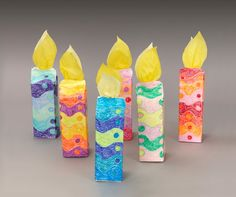
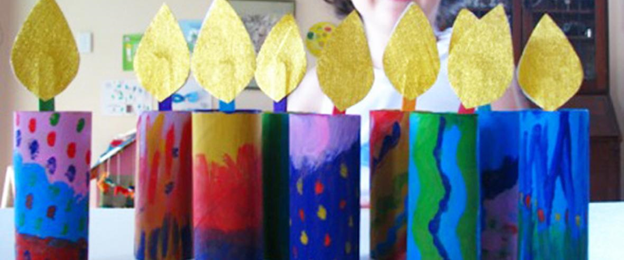
Back to top
The Story of Scratches: Meaningful Objects
For much of history, the Jews were a nomadic people and when they were traveling from place to place, they brought with them what was most valuable to them. When they traveled in the desert, they were instructed to bring the mishkan, tabernacle or holy space, with them everywhere they went. Certainly, everything in the mishkan was holy, was special and important to the Jews.
Travel isn’t easy, especially on foot, and as they traveled, items would get dinged, scratched or damaged. The Jews are a resilient people, and they did not let these scratches and dings ruin the meaning or value of these items. In fact, some items became more valuable once they had a scratch or ding that was paired with a beautiful story of tenacity, resilience and hope.
Directions:
1. Find an item in your home that has meaning BECAUSE it has gone through a lot with you and your family. This item should have had meaning prior to it getting dinged up and have even more meaning now that it has a story behind it.
2. Think about the different ways this item has impacted you or your family and use these questions to guide your discussion.
- What makes this item meaningful to your family?
- What is the story behind the item and any dings or scratches it may have?
- How does it make you feel when you look it at?
- Why did you choose this item for your home sanctuary?
3. Write about the meaning behind the item that you have chosen using these formats as your guide.
- My _____ impacted my family because when we were ________ it really ______ us. We are so ________ to have _______.
- One time when my family went ______ something _____ happened!
- I have this ______ and it has gone ______ with me. It has provided me with ______ and one time ______ happened to it! I was so __________.
Example:
The bracelet I wear every day impacted my family because my grandfather was wearing it when he passed away and now I have it. It has helped me in many hard times. My bracelet has traveled with me everywhere since my grandfather passed. Each scratch mark and dirt stain remind me that my grandfather is always with me, each place I go. I want to bring my bracelet to my Sanctuary because it helps me feel my grandfather’s presence. Even though my bracelet is beat up, it connects me to a man that means so much to me and who I know listens when I pray.
Back to top
Making Space Holy: Bezalel Decorates the Mishkan
The biblical mishkan was made of acacia wood and adorned by elegant décor and a cover with gold angels. When God gave instructions for the constructing of the mishkan, God appointed Bezalel, an ordinary man, to be the architect. But he didn’t do it alone. He decorated the mishkan with the help of other ordinary people, who were instructed to bring gifts of the heart and things that were meaningful to them for decoration.
In this way, the mishkan was created by the entire community and included items important to each individual in the community. For example, one person might find something in nature beautiful enough to bring, while another might bring a beautiful piece of jewelry. Today, it is up to each of us as part of a community to make our sanctuaries holy spaces. What will make your home sanctuary holy?
Directions:
Younger Students:
1. Using paper, markers and whatever other supplies you have lying around, make Rosh Hashanah pictures to decorate your space in preparation for the holidays.
2. Pictures could include apples and honey, shofars, or any other images that make you think of a sweet new year.
3. Make sure each member of the family creates something so that, like Bezalel combining the items brought by the Jewish people, your space has something from each individual.
4. Affix the images to the walls of your home sanctuary.
5. Optional: Discuss other ways you can set your holy space apart from the other spaces in your house.
Older Students:
1. Discuss as a family what makes a space holy using these questions as a guide:
-
-
- What, if anything, already makes your home sanctuary holy?
- What do you need to add to the space to make it holy?
- How can you beautify your space, as Bezalel did with the mishkan, so that it reflects all the members of your family?
2. Based on your answers to the questions above, beautify your home sanctuary so that when you enter it, you can see each family member’s contribution.
Back to top